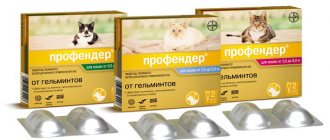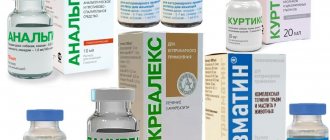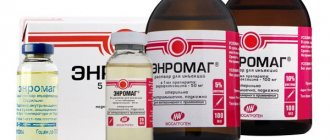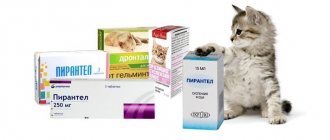Ivermek is prescribed for cats against worms and in case of infection with other parasites. The medicine is available for use for therapeutic and prophylactic purposes. In veterinary medicine, the drug is used not only to treat felines. You can also give injections with Ivermek to farm animals and birds. Before using an antiparasitic drug, carefully study the instructions for use, find out what contraindications there are and whether an overdose is possible.
Composition, form and effect on the kitten’s body
The medicine Ivermek ON is produced in the form of a solution that is used for injection. It is also possible to purchase “Ivermek” gel intended for oral use at a veterinary pharmacy. The drug contains 10 mg of ivermectin and 40 mg of tocopherol acetal or vitamin E. Additional ingredients of Ivermec for kittens and adults are:
- dimethylacetamide;
- polyethylene glycol 660-hydrokeistearate;
- injection water;
- benzyl alcohol.
The solution can be purchased in bottles with a plastic cap of 400, 500 and 1000 ml. The medicine "Ivermek" must be given to a cat in case of parasitic infection. The action of the drug is aimed at eliminating the following parasites:
This drug allows you to rid the animal’s body of nematodes.
- bloodsuckers;
- roundworms;
- helminths;
- nematodes;
- lice;
- fleas;
- gadflies or ticks;
- subcutaneous, nasopharyngeal or cutaneous parasites.
The abstract for Ivermek informs owners that the active and auxiliary substances affect the central nervous system of the parasite, as a result of which it dies. The medicine does not accumulate in the cat’s body and is excreted well along with urine and bile.
latest comments
I was looking for WHAT TIME DOES WORMS COME OUT AFTER IVERMEC?
. FOUND! Good evening, on March 6, I injected the piglets with Ivermek, on March 8, the pig got worms, about 25 of them, tell me, after how many days do I repeat the injection?
the piglets began to fidget. After Ivermek, they came out the next day. Milk from dairy animals is allowed to be used for food purposes no earlier than 28 days after the last administration of Ivermek. While working, it is forbidden to drink, smoke or eat. How and when do worms come out after taking Vermox: the principle of action of the drug. It will not be possible to remove helminths living in other organs, especially larvae that form cysts (echinococcus).
Worms can also enter the farm through newly acquired individuals. Ivermek; Alben. The worms begin to die and come out naturally on the second day after taking the drug. Directions for use: the drug is taken during or after meals once a day. From roundworms ─ Medamin, Pirkon, Pirivinium, Ivermek, Vanquin. After Vermex, live worms come out. The doctors explained that the worms stuck to the intestinal walls, so they don’t come out either. After Ivermex was injected, the worms came out in TONS, I just haven’t seen anything like this!
The worms came out for some time and stopped. Ivermek (Nita-Farm). DESCRIPTION. An antiparasitic drug, which is a unique slaughter of animals treated with Ivermek for meat is permitted no earlier than 28 days after administration of the drug. How long does it take for worms to come out after Ivermek - NO MORE PROBLEM!
It is recommended that animals be allowed to mate no earlier than 2 weeks after the Ivermek injection. On the pasture, only after the dew has disappeared, when the sun has burned through all the intermediate hosts of worms, swampy areas and puddles with tadpoles. How do worms come out after Vermox?
Helminths that are sensitive to Larger worms (pork tapeworms, roundworms) may not be taken within the specified time. Do not purchase medications directly or through intermediaries on the Internet if you do not want to. The drug must be taken with meals or immediately after meals. To prevent reinvasion, the course of treatment is repeated after 2-3 weeks. How worms come out under the influence of the drug Vermox. Even companion dogs (Yorkies, Chihuahuas, Toy Terriers) never come out. Puppies suffer more severely from worms, and young dogs a little less, while in lactating females preventive deworming is carried out after 2 weeks after the birth of the puppies, and then at intervals of 2 weeks until weaning. Ivermec (JSC Nita-Pharm, Russia) Injection 1% solution in 1 ml even comes out of the anus on its own, without going to the toilet. They advised me to take Ivermek (injection) - I did it, it went away. After some drugs like Prazicide, such a thing is not uncommon - worms from the mouth and butt within a week or two. Why after the injection of Ivermek, the sheep’s legs seemed to cramp, the stomach was swollen, at first it crunched its teeth. Big plus that in addition to demodicosis, it copes with many types of skin parasites and worms, it has a wide spectrum of action. How long does it take for the worms to come out?
Another argument must be taken into account when discussing the topic “How many worms come out after anthelmintics?
»How to inject Ivermek into cats and dogs. Ivermek is a medicine for cats and dogs, an effective remedy for parasites. He hugs patients, licks them and stays nearby while they recover from anesthesia after surgery, without using scientific literature and patient reviews, we will try to figure out how worms come out after Vermox and Efficacy and indications Instructions for using Vermox How do parasites come out?
Mistakes during administration. This should not be expected after Vermox. Dead worms will be passed out in the stool. This is necessary to eliminate not only adult parasites, but also their eggs, from which new worms appear after a while. Medicine for worms Nemozol: reviews of the drug, how long after taking do the parasites die?
How do worms come out when using this medication?
How long after taking the medicine do the worms die and come out?
What are the indications?
A pet needs an Ivermec injection for parasitic infections. The medicine copes with larval and adult sexually mature forms of endoparasites. Recommended for kittens and older individuals when infected with nematodes and sarcoptic mites. Indications for the use of Ivermek are the following pathologies:
The drug can be prescribed to a fluffy cat who has been diagnosed with demodicosis.
- toxascariasis;
- hookworm;
- uncinariasis;
- notoedrosis;
- demodicosis;
- otodectosis;
- sarcoptic mange;
- gastrointestinal or pulmonary helminthiasis.
Ivermek for cats: fighting parasites
The drug “Ivermek” is suitable for combating:
- mites (otodectosis) living in the animal's ear. They cause increased body temperature, severe itching, and dark discharge from the ears.
- Fleas and other blood-sucking insects.
- Helminths (toxocariasis, hookworm), which parasitize the small intestine. They often provoke diarrhea, constipation, the pet becomes lethargic, and the appetite worsens.
Attention!
During infection with some types of worms, blood may be observed in the feces.
Instructions for use
An injection of Ivermek OR is required inside the muscle; veterinarians often perform injections into the back thigh of the cat. To carry out the manipulation, insulin syringes with a thin needle are used. Some experts prescribe 0.1 ml per 1 kg of cat weight, but this dosage is incorrect. This is also a lethal dose for a cat, since Ivermec has a high level of toxicity. It is better to stick to this use of the drug - 0.2 ml per 10 kilograms. For mild pathology, one injection is enough, but if the infection is severe, the injection is given to the cat again after 10 days.
Ivermek spray is more convenient and safe to use. It is intended for external infestation of cats with fleas and ticks. Processing is carried out as follows:
Treatment of problem areas of the furry with a spray must be carried out after wearing gloves.
- The damaged areas are cleaned of any crusts that have formed. You can use a special solution.
- Spray a small layer of Ivermek onto the fur. When manipulating, a person must wear rubber gloves.
- During treatment, not only the affected skin is captured, but also 1-2 cm of healthy epidermis.
- After the procedure, a special collar is put on the cat to prevent the product from being licked from the fur. If there is no device in the house, then the pet is held until the drug dries completely.
It is forbidden to spray Ivermek spray in the area of the animal’s eyes or mouth, since serious complications may occur if it gets on the mucous membranes or in the respiratory tract.
How and in what dosage to use the drug
Since the drug is prescribed to combat parasites that torture the animal from the inside, according to the instructions, the drug is used in the form of intramuscular injections. The instructions for cats establish acceptable dosage values for the drug, which directly depend on the weight of the animal, at a rate of one tenth of a milliliter per five kilograms of weight. For the purpose of prevention, one injection may be quite enough, but if we are talking about treatment, the injection should be given every ten or fourteen days, depending on the complexity of the disease.
This two-week period between injections is provided as a precautionary measure to avoid an overdose of the drug. Otherwise, an overdose can cause intoxication of the body, and even death.
In order to remove excess drug from the animal’s body, it is necessary to administer a large amount of fluid and diuretics.
To the question “Where should I inject the drug?” There are two answer options, the first of which is at the withers, the second option is at the knee fold. In both the first and second cases, it is recommended that the injection be given by an experienced specialist himself or under his direct supervision and control.
The drug has a wide spectrum of action, this means that it is also applicable to dogs to combat various ailments. They can be treated with injections and gel, which is sold in tubes. The gel is intended for external use. It is recommended for use two to four times at intervals of five or seven days to avoid overdose. It is actively used to treat lichen in dogs. The gel contains components such as panthenol (promotes rapid healing of wounds and various types of fungal formations on the skin) and lidocaine (has anesthesia properties). Moreover, the gel prevents itching. The main advantage of the gel is that the drug is not absorbed into the blood, but accumulates on the surface of the skin, providing a therapeutic effect lasting five to seven days.
Adverse reactions: why are they dangerous?
When choosing Ivermek and its analogue to treat parasites in a cat, you must strictly follow the prescribed dosage. Since the medication has a toxic effect, serious consequences are possible. Side effects from using an antiparasitic drug are:
Often after such therapy, the fluffy will produce a lot of saliva.
- increased salivation;
- increased tearfulness;
- gagging;
- muscle tremors;
- nausea.
What to do if Ivermek exceeds the recommended dosage?
This is indicated by the following dangerous syndromes:
- Paralysis of the limbs, most often the hind limbs;
- Rapid or heavy breathing;
- Pupil dilation;
- Gait disturbance.
Some animals also experience muscle tremors, high salivation, copious and frequent urination and defecation, which often go away on their own.
All these signs are a consequence of intoxication, without eliminating which the owner risks losing the pet. The very first remedy is a diuretic. Veterinarians use it as a detoxification therapy. There are other special drugs to restore all lost functions of the animal’s body, but they are determined by a specialist. We must remember that pregnant, lactating, sick and weakened four-legged pets are not subject to antiparasitic treatment.
Among the advantages of the drug is its low price. One milliliter for injection costs about 45 rubles. While the spray and gel have a higher price - 264 and 400 rubles, respectively. Analogues are also produced - iversect and ivomek.
Analyzing the reviews, both positive and negative were noted. The positive aspects of using Ivermek are its effectiveness, affordable cost, reduction of itching, rapid healing of wounds and accelerated hair growth in the affected areas. The animal becomes calmer and healthier. The drug does not have a sharp, pronounced odor. Negative reviews of the product note side effects and the presence of contraindications. Most often, all the negative aspects of the drug are associated with exceeding the dosage. Therefore, mandatory compliance with all recommendations will only benefit your pet!
Is it possible to overdose?
In most cases, the drug is used to treat cattle, so smaller pets require much smaller doses. If the dosage prescribed by the veterinarian is followed, there are no cases of overdose. When the owner neglects the specialist’s recommendations, the animal is likely to vomit. If the treatment period or the amount of the recommended solution is exceeded, the cat’s general condition sharply worsens; they may involuntarily defecate and urinate on themselves. In this case, the drug is discontinued, and if the symptoms do not go away after a few days, then contact a veterinarian for help.
Storage period and conditions
The medicine is subject to rapid destruction when interacting with the external environment, so it is used immediately after depressurization. The product is valid for 18 months from the date of manufacture, 40 days from the date of opening the bottle.
Store the medicine away from food and animal feed, in a dark, dry place. Storage temperature range from 0°C to 25°C. After the expiration date, do not use, but dispose of. Empty containers cannot be used for household purposes; they are disposed of.
Parasites bring natural suffering to pets, since animals depend on their owners, be attentive to them. If your pet is behaving in some way: it has become apathetic, has lost its appetite, or is constantly itching - this is a good reason to visit the veterinarian.
Contraindications
It is prohibited to give Ivermek to a kitten that is less than 12 weeks old, and the product should not be used in the following cases:
During the period of feeding offspring, females cannot be treated with this drug.
- pregnancy in a cat;
- feeding kittens with milk;
- diseases of infectious origin;
- liver pathologies;
- individual intolerance to the components of the drug.











